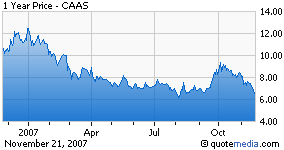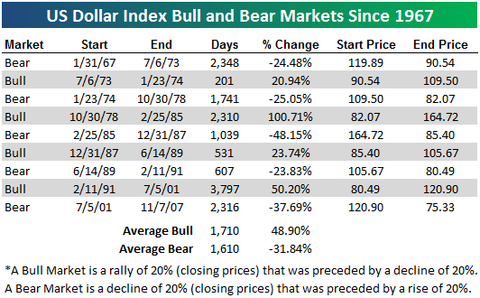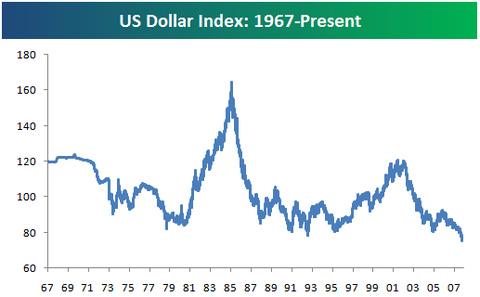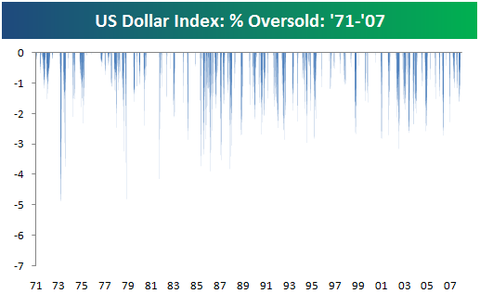Reader's Question: How does a buy-and-hold strategy compare to a trading strategy for ETFs [and stocks in general]?Your question pertains specifically to exchange-traded funds (ETFs); however, because the buy-and-hold versus trade decision is basically the same for individual stocks, I will answer within the general context of equity-style investing.
Investing vs. TradingThe primary difference between a buy-and-hold approach to investing and a trading strategy is one's time horizon. To some extent, the distinction is relative: a day-trader considers any holding period longer than a day or two to be investing, whereas a buy-and-hold investor might consider any portfolio with turnover exceeding just 10% or 20% per annum to be trading. For concreteness, however, let's define "investing" as holding any position for a year or longer, in line with the cut-off for tax purposes between long-term and short-term capital gains. Within this definition, managers running portfolios with turnover exceeding 100% per year will be deemed to be "trading."
Rationally speaking, the decision to invest or trade should be based on your assessment of two quantities:
"Pick-Up" in Expected Return: How much pick-up in return do you expect to gain by trading, i.e., by switching from one asset to another, such as selling one stock to buy another?"Frictional" Costs of Trading: What are the frictional costs including broker's commissions, bid-offer spread, tax impact of trading, and additional administrative time required to keep your records in order and account for trades?Whenever expected pick-up exceeds frictional costs, it makes sense to trade out of one asset and into another that promises the higher return.
If markets are efficient, with perfect and instantaneous information flow among all participants, no pick-up in expected return should be available from switching out of one asset and into another; instead, frictional costs will only drag down returns. On the other hand, if it is possible to use available information to one's advantage to outsmart others, then trading can be a highly profitable business.
Prominent Winners and LosersA glance at popular lists of the rich and famous shows that at least a few people have been amazingly successful trading the markets. Here are some well-known traders on the
Forbes list of the 400 wealthiest Americans:
George Soros (age 77): #33 on list, $8.8 billion net worth. Bachelor’s, London School of Economics. Founded Quantum Fund with Jim Rogers. With Stanley Druckenmiller, "broke" British pound in 1992, made $1 billion profit. Lost hundreds of millions with ill-timed investments in former Soviet Union 1996.Steven Cohen (51): #47, $6.8 billion. Bachelor’s, Wharton, U. Penn. Founded hedge fund SAC Capital 1992 with $25 million in assets. Today manages $14 billion. Charges 3% of assets, 35% of profits; has returned an average of 34% net of fees each year since 1992.James Simons (69): #57, $5.5 billion. Math Ph.D., UC Berkeley. Founded Renaissance Technologies 1982. Quantitative hedge fund uses complex computer models to analyze and trade securities. Fees as high as 5% of assets, 44% of profits. A $2.5 million investment in his funds in 1990 would be worth $1 billion today (for a 42% annualized return). Hires Ph.D.s over M.B.A.s. $25 billion institutional fund RIEF so far performing below expectations.Stanley Druckenmiller (54): #91, $3.5 billion. Bachelor’s, Bowdoin College. Orchestrated billion-dollar raid on the British pound in 1992 with timely short position. Believed to help generate string of 30% returns for Soros' Quantum Fund. Duquesne Capital Management, runs No Margin Fund.Bruce Kovner (62): #91, $3.5 billion. Bachelor’s, Harvard. Started trading soybeans; turned $3,000 he borrowed on his credit card into $45,000. Forgot to hedge, lost half the profits. Founded Caxton Associates 1983. Caxton Global Investments hedge fund has returned 25% annually net of fees. Assets: $15 billion.Paul Tudor Jones II (53): #105, $3.3 billion. Economics, Bachelor’s, Univ. of Virginia. Early success trading cotton on Wall Street. Founded Tudor Investment Corp. hedge fund 1980. Predicted 1987 stock market crash, returned 125% net of fees that year. Assets now $20 billion. Estimated average annual returns 24%; down this year amid summer's violent market turmoil.Kenneth Griffin (38): #117, $3.0 billion. Bachelor’s, Harvard. Started investing as undergrad, managing $1 million of family's, friend's money by senior year. Founded Citadel Investment Group 1990 with Frank Meyer's money. His hedge funds said to have averaged 20% net of fees annually. Assets under management exceed $16 billion.David Shaw (56): #165, $2.5 billion. Ph.D., Stanford. Investment geek uses complex algorithms to capitalize on tiny anomalies in the stock market. Former professor of computer science at Columbia U. Launched hedge fund D.E. Shaw & Co. Assets have swelled from $28 million to $34 billion in 20 years (or 43% annual compounded asset accumulation).David Tepper (49): #239, $2.0 billion. M.B.A., Carnegie Mellon. Ran junk bond desk at Goldman Sachs. Started hedge fund Appaloosa Management in 1992. Fund up 150% in 2003; believed to have averaged 30% returns net of fees since inception. Manages $7 billion.Louis Bacon (51): #286, $1.7 billion. Literature, Bachelor’s, Middlebury College. Founded Moore Capital in 1989; returned 86% in first year on savvy bet that Gulf war would drive up oil prices. Assets under management: $13 billion. Last year returned 16.7% after fees (25% of profits, 3% of assets).Daniel Och (46): #317, $1.5 billion. Bachelor’s, Wharton, Univ. of Penn. Took job in arbitrage at Goldman Sachs 1982; worked with Eddie Lampert , billionaire Richard Perry. Left to found Och-Ziff hedge fund with $100 million initial investment from Ziff brothers. Consistent returns: 16.5% a year after fees. Manages $29.1 billion.Israel Englander (59): #317, $1.5 billion. Bachelor’s, NYU. Founded investment outfit Jamie Securities 1980s; firm collapsed. Created Millennium Partners 1990; fund said to have returned 17% net of fees. Assets under management $11.5 billion. Employees created 100 legal shell companies in order to market time mutual funds.The persistent 15% t0 40% or higher annual returns these traders show is evidence that it
is possible to realize consistent profits trading the market.
Lest we become too carried away with these success stories, we should also keep in mind that there have been many equally prominent "blow-ups" of risk-taking traders, including:
Victor Niederhoffer, one of Soros's former colleagues, whose funds failed twice, in 1997 and again this year;
John Meriwether's Long-Term Capital Management, the multi-billion dollar hedge fund run by ex-Salmon traders and even a couple of economics Nobel prize winners, which collapsed in 1997; and Amaranth Advisors, which spectacularly lost $6 billion in one week on natural gas futures in September 2006. This year's subprime crisis is another example of how businesses, investments and trading strategies that have been profitable for many years can suddenly turn sour. Then, too, think about all the unlucky traders who lose money so quickly that we never get a chance even to hear about them!
Base Strategy: Buy-and-HoldThe only certain way to know whether you yourself have the ability become a successful trader is to commit both significant time and capital to trying. Unfortunately, most people have neither the time nor capital to spend finding out. Also, for those who seriously begin trading but fail, the costs can be very high, both financailly and emotionally.
In my opinion, instead of launching off and haphazardly trying your luck at trading, it makes sense at least initially to pursue a buy-and-hold strategy to exploit certain advantages it offers:
1.
Long-Term Returns Favor Equities: The nature of capitalism as we know it in the U.S. and in most parts of the world is that laws and regulations are skewed to promote economic growth, corporate profits, and wealth generation for stockholders. In this environment, risk-taking buy-and-hold equity holders more often than not end up with higher returns than bondholders and cash-rich non-risk-takers. Therefore, it makes sense to allocate as much of your portfolio as you can to equities, reserving for cash and bonds only what you need for emergency living expenses (e.g., six months' income in case you lose your job) or predictable future expenses (e.g., a college fund for children). While it is very difficult to predict whether equities will outperform bonds and cash in any given year, over periods of 10 or 20 years or longer, equities have generally outperformed.
2.
Cost Efficiency: Compared to trading, buy-and-hold investing controls costs by keeping broker's commissions and other frictional costs to a minimum. Though not as evident as a trading commission, the bid-offer spread is a cost that can often be larger than commissions. To give an extreme example, a micro-cap "penny" stock with a $0.06-$0.08 bid-offer (you can buy at $0.08 and sell at $0.06 in an unchanged market) actually has round-trip execution costs of an enormous 25% of one's initial investment! At the other end of the spectrum are exchange-traded funds, the most liquid of which is the S&P Depositary Receipts (AMEX: SPY) with round-trip bid-offer costs of just 0.007% (or less than 1 b.p.). More typically, moderately liquid mid-cap individual stocks have bid-offer spreads of about 0.50% (50 b.p.).
3.
Tax Efficiency: Keeping portfolio turnover to a minimum through buy-and-hold investing is also more efficient from a tax point of view. First of all, the long-term capital gains tax rate of 15% that applies to positions held for more than a year is substantially lower than the ordinary income tax rate running as high as 28% that applies to short-term capital gains on positions held for a year or less. For certain types of trading accounts, the IRS offers a favorable 60%/40% split between long-term and short-term capital gains tax treatment, which produces an effective tax rate of 20.2% (of course, higher than the 15% pure long-term gains rate). Also, since taxes on gains are due only when securities are eventually sold, capital gains tax can be deferred indefinitely into the future through extending buy-and-hold positions without selling for many years.
While it may seem simplistic, a buy-and-hold approach to investing, characterized by continuously holding a very high percentage of equities with only very infrequent though carefully considered buy-sell decisions, can, in my opinion, give small retail investors a slight "edge" over other investors and traders based on the efficiencies cited above.
Numerical ComparisonTo gauge the impact of frictional costs on returns, let's compare two portfolios over a 10-year period in a market that returns 10% annually:
Buy-and-Hold: Assume no turnover. At 10% annual appreciationn, $100 grows to $259 after 10 years. After payment of 15% long-term capital gains tax on the $159 gain at the end of year 10, the net portfolio value becomes $235, for an annualized after-tax return of 8.94%.Trading: Assume 200% annual turnover, or the equivalent of two round-trip trades per year at a cost of 0.50% per round-trip. Trading costs as stated and annual taxes of 28% on short-term gains reduce the 10% annual market appreciation to (10% - 2 x 0.50%) x (1 - 0.28), or 6.48%. At this after-tax growth rate, an original $100 investment becomes $187 after 10 years.Assuming that trading produces no pick-up in return, the frictional trading costs and additional tax lead to an inferior after-tax annual return 246 b.p. lower (8.94% vs. 6.48%) than the return available through buy-and-hold investing. On a pre-cost, pre-tax breakeven basis, the trading strategy will need to outperform the buy-and-hold alternative by a full 342 b.p. annually in order for trading to beat the buy-and-hold alternative.
As a rough rule of thumb, then,
you should engage in trading only if you honestly believe that your buy-sell decisions give you at least a three or four percentage point advantage annually (and more if your turnover exceeds 200% per year) above the buy-and-hold alternative.
Self-Assessment: What's My Trading "Edge"?Expressed another way, the buy-and-hold versus trading decision really boils down to having an "edge" large enough to overcome the costs of trading. What in particular about you, your personality, your abilities, and your current situation gives you a competitive advantage over others in the market? Based on the information you can easily get your hands on, digest and analyze, do you have an edge over professionals who devote themselves full-time and make careers out of trading the market?
While a genius-level of business and financial acumen may not be strictly necessary for wealth-building, I would contend that your odds of becoming a successful investor or trader will be greatly enhanced if you know what your edge is. If you plan to trade ETFs or large-cap stocks over a short-term time horizon, keep in mind that you'll be competing with Wall Street traders and hedge funds who usually have access to more up-to-the-minute newswires, customer flow information, and analytical tools than you do. Your odds of success may be slightly better in small-cap and penny stocks, asset classes that more sophisticated investors often avoid due to limited liquidity and trade size (
Tim Sykes, whose claim to fame is trading his way from $12,415 to $1.65 million in just four years, day-trades small-cap stocks and is attempting to teach us all how it can be done again).
Over the years I have looked at many fundamental, technical and sentiment-based possibilities for constructing a system for beating the market, always searching for a methodology to ensure at least a 70% winning trade percentage. From one (perhaps too naive and hopeful?) point of view, given how readily availability price, volume, earnings and other quantifiable time series are, it seems that trading
ought to be a "science" amenable to analysis and predictability. Unfortunately, from what I have seen so far, analytical trading rules do not appear to produce excess returns in any consistent and reliable way. Also, to date, I have yet to meet anyone who has a trading system that runs without human intervention and produces consistent excess returns. From what I can tell, trading is more like a game involving both luck and skill than a predictive science.
To Trade or Not To Trade?Whether to engage in buy-and-hold investing or to pursue a short- or middle-term trading strategy, then, really depends on your own abilities and risk preferences. For the vast majority of people, I suspect that a buy-and-hold strategy will bear larger and more fruit than an active trading strategy. In my own case, I currently follow a buy-and-hold approach, targeting no more than 10% annual turnover to keep trading costs and taxes at a minimum.
Concurrently, I continue my search for a Holy Grail of sorts that is capable of producing winning trades at least 70% of the time (which I view as equivalent to a low-C grade, i.e., barely passing). The day I convince myself that I have a working system that meets this 70% threshold, I will begin to trade, putting real money at risk.
By the way, to anyone reading this: If you or someone you know has a trading system that produces consistent and reliable above-market returns, and don't mind sharing a little information about it, please leave a comment. We would all love to hear about it.

 Here's our summary of articles and data points on the housing market. It's part of Seeking Alpha's
Here's our summary of articles and data points on the housing market. It's part of Seeking Alpha's 








